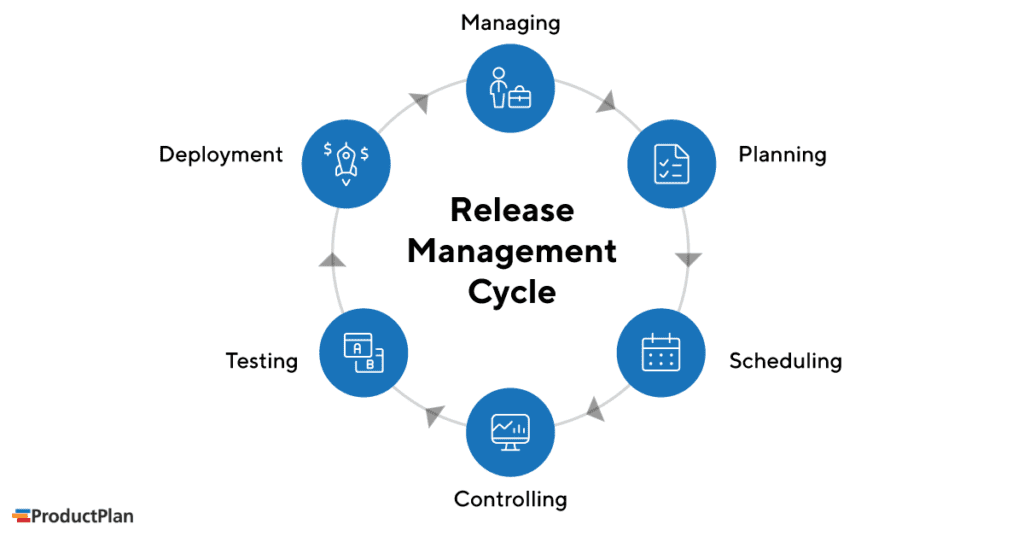What Is Release Management?
Release management is one of those modern business terms that has several meanings. For IT departments, the term describes overseeing a software release within the company, including planning, testing, and deploying the application. Release management describes both the tactical and strategic steps involved in preparing a product for launch for product managers.
This post will discuss the second definition of release management, driving a release from a product management perspective.

What Does Release Management Include?
For a product team, a successful release management plan will include a wide range of steps. Here are some examples, broken down into tactical and strategic categories.
Strategic steps:
- Determining the right user persona for the product and developing an effective value proposition for that user.
- Developing compelling messages for existing customers and plans to deliver those messages when the company releases a new or updated product.
- Prioritizing the new product’s functionality and assigning only on the most strategically valuable elements for the development team to work on.
- It sets appropriate key performance indicators (KPIs) to assess the product’s success after the release.
Tactical steps:
- Making sure the development department is prioritizing its work according to plan and hitting its completion deadlines.
- Creating web pages, sales demos, help text in the app itself, and other tools to ensure a smooth and successful launch.
- If the release will be an update to an existing product, making sure that all existing content on the web, in sales materials, and in the app are all up to date.
- Coordinating with the support, pre-sales, and sales teams to make sure they’re ready for launch.

Which Teams Are Involved in Release Management?
Product management drives release management. But for the release to succeed, the product team will need the help and coordination of several other teams, including:
Development
The product team needs to communicate to developers the expected completion dates for each aspect of the product.
Support
When the product becomes available to users, the support team needs to be ready to answer questions and help users through challenges navigating the product.
Sales
The sales department needs both training and materials (datasheets, presentations, demo videos) to help prepare them to sell to prospects.
Marketing
The product team needs to work closely with marketing to develop effective messaging and materials to educate and persuade prospective users to try or buy the product.
Three Ways Product Manager Can Build a Release Management Plan
For a company that regularly updates its products and pushes those updates to the customer, release management is ongoing. A product manager will always be engaged in some aspects of release management.
1. Coordinate early and often with your cross-functional team
It includes the departments discussed above—development, sales, marketing, support—and any other teams involved in your product’s development. The more these teams understand your strategic and tactical plans for the product’s release, the more effective they can be helping you achieve a successful launch.
2. Create checklists for the steps in your release plan
With all of the tasks involved in a successful release management plan, it can be easy to forget some. Have you ensured all of the content in the app reflects the latest messaging for the version you’re about to release? Does marketing have all of its creative assets in place to launch its campaign on release day? Has your support team completed its training on the product before launch?
The easiest way to make sure you don’t leave tasks undone is to create a checklist and refer to it frequently.
3. Build and share a strategic product roadmap
Develop a roadmap that communicates your company’s strategic plans and goals for the product. Then make sure all of the teams who will contribute to the product’s success in the market have access to that roadmap.
You will want your marketing team, for example, to understand why you’ve strategically prioritized certain product functionality. It will help them create more compelling messaging to articulate the benefits of those key features.
Note: You want to make sure your cross-functional team always sees the current roadmap, and that they don’t mistakenly grab an outdated version. You will want a web-based roadmap app rather than to use a static spreadsheet or presentation file to create your roadmap.
Related Terms:
release plan / continuous delivery / continuous deployment / product development process / go-to-market strategy
Learn More About Bringing Products to Market:
Read our book: The Anatomy of a Product Launch